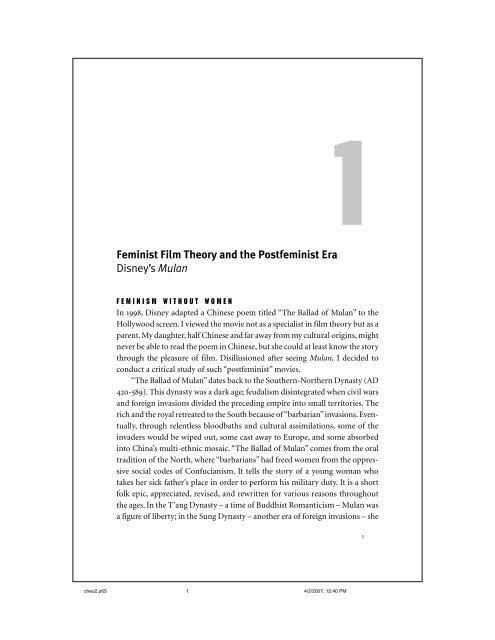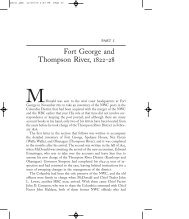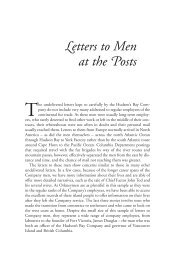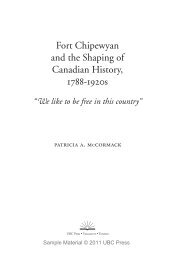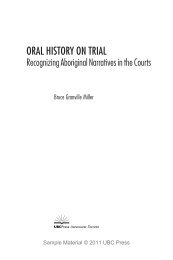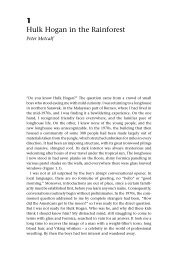Feminist Film Theory and the Postfeminist Era Disney's Mulan
Feminist Film Theory and the Postfeminist Era Disney's Mulan
Feminist Film Theory and the Postfeminist Era Disney's Mulan
You also want an ePaper? Increase the reach of your titles
YUMPU automatically turns print PDFs into web optimized ePapers that Google loves.
<strong>Feminist</strong> <strong>Film</strong> <strong>Theory</strong> <strong>and</strong> <strong>the</strong> <strong>Postfeminist</strong> <strong>Era</strong><br />
Disney’s <strong>Mulan</strong><br />
1<br />
Feminism without Women<br />
In 1998, Disney adapted a Chinese poem titled “The Ballad of <strong>Mulan</strong>” to <strong>the</strong><br />
Hollywood screen. I viewed <strong>the</strong> movie not as a specialist in film <strong>the</strong>ory but as a<br />
parent. My daughter, half Chinese <strong>and</strong> far away from my cultural origins, might<br />
never be able to read <strong>the</strong> poem in Chinese, but she could at least know <strong>the</strong> story<br />
through <strong>the</strong> pleasure of film. Disillusioned after seeing <strong>Mulan</strong>, I decided to<br />
conduct a critical study of such “postfeminist” movies.<br />
“The Ballad of <strong>Mulan</strong>” dates back to <strong>the</strong> Sou<strong>the</strong>rn-Nor<strong>the</strong>rn Dynasty (AD<br />
420-589). This dynasty was a dark age; feudalism disintegrated when civil wars<br />
<strong>and</strong> foreign invasions divided <strong>the</strong> preceding empire into small territories. The<br />
rich <strong>and</strong> <strong>the</strong> royal retreated to <strong>the</strong> South because of “barbarian” invasions. Eventually,<br />
through relentless bloodbaths <strong>and</strong> cultural assimilations, some of <strong>the</strong><br />
invaders would be wiped out, some cast away to Europe, <strong>and</strong> some absorbed<br />
into China’s multi-ethnic mosaic. “The Ballad of <strong>Mulan</strong>” comes from <strong>the</strong> oral<br />
tradition of <strong>the</strong> North, where “barbarians” had freed women from <strong>the</strong> oppressive<br />
social codes of Confucianism. It tells <strong>the</strong> story of a young woman who<br />
takes her sick fa<strong>the</strong>r’s place in order to perform his military duty. It is a short<br />
folk epic, appreciated, revised, <strong>and</strong> rewritten for various reasons throughout<br />
<strong>the</strong> ages. In <strong>the</strong> T’ang Dynasty – a time of Buddhist Romanticism – <strong>Mulan</strong> was<br />
a figure of liberty; in <strong>the</strong> Sung Dynasty – ano<strong>the</strong>r era of foreign invasions – she<br />
cheu2.p65 1<br />
4/2/2007, 12:40 PM<br />
1
epresented <strong>the</strong> Chinese people’s desire to reclaim <strong>the</strong> l<strong>and</strong> conquered by nor<strong>the</strong>rn<br />
neighbours; in <strong>the</strong> Ming Dynasty, she was used to resurrect <strong>the</strong> Confucian<br />
virtue that dem<strong>and</strong>s that children make sacrifices for <strong>the</strong>ir parents’ sake. During<br />
<strong>the</strong> communist revolution, she was praised as a proletarian woman warrior<br />
<strong>and</strong> liberator.<br />
Each age reconstructed <strong>Mulan</strong>’s story to serve its own social purposes, so<br />
<strong>the</strong>re is no point in criticizing Disney simply because it appropriated this Chinese<br />
folk tale. Stories have to be changed; as I advocate throughout this book,<br />
stories are an agent of change. Never<strong>the</strong>less, one must guard against an unconditional<br />
surrender to <strong>the</strong> transformative power of <strong>the</strong> film art because <strong>the</strong> same<br />
power can be used in <strong>the</strong> service of social conformity. A critical inquiry should<br />
highlight how <strong>the</strong> source material has been changed: in <strong>Mulan</strong>, Disney reworked<br />
<strong>the</strong> story to match what it perceived to be <strong>the</strong> belief system of its viewers; in<br />
turn, <strong>the</strong> film itself frames <strong>the</strong> ideology of American culture.<br />
In constructing <strong>Mulan</strong>, Disney extracted one basic element from <strong>the</strong> tale:<br />
<strong>Mulan</strong> takes her fa<strong>the</strong>r’s place to fight in <strong>the</strong> army. P<strong>and</strong>ering to postfeminist<br />
America, <strong>the</strong> rest of <strong>the</strong> storyline is a battle against an American version of<br />
Chinese patriarchy that forbids women from becoming soldiers. The characterization<br />
of <strong>Mulan</strong> contradicts her physical portrait. Disney’s <strong>Mulan</strong> has <strong>the</strong><br />
mind of a superhero; she <strong>and</strong> her comrades march to <strong>the</strong> front only to find that<br />
invading Huns have wiped out China’s main army, but against desperate odds,<br />
<strong>the</strong>y choose to st<strong>and</strong> against <strong>the</strong> Hun advance. Being physically <strong>the</strong> weak link<br />
of her squad, she almost fails her training <strong>and</strong> fights only one battle. As <strong>the</strong><br />
heroine, she is responsible for transforming an imminent defeat into victory,<br />
yet she does so nei<strong>the</strong>r by skill nor military strategy. She wins <strong>the</strong> battle by<br />
firing one cannon at a nearby snow-covered mountain, creating an avalanche<br />
that engulfs almost <strong>the</strong> entire Hun army. This plot development is symptomatic<br />
of <strong>the</strong> American perspective: a large-scale war can easily be won with precision<br />
bombing, but psychopathic terrorist groups present real trouble.<br />
The conflict between <strong>Mulan</strong> <strong>and</strong> Chinese patriarchy comes immediately<br />
after <strong>the</strong> avalanche. <strong>Mulan</strong>’s comrades discover that she is a girl <strong>and</strong>, following<br />
<strong>the</strong> army’s cruel patriarchal law, ab<strong>and</strong>on her on <strong>the</strong> snowy mountain. Because<br />
she has been left behind, she learns that a small but fierce group of Huns has<br />
survived <strong>and</strong> plans to take <strong>the</strong> emperor’s city. Entering <strong>the</strong> city herself, she attempts<br />
to warn people about <strong>the</strong> impending danger, but nobody believes her<br />
because she is female. The Huns duly arrive <strong>and</strong> take <strong>the</strong> emperor hostage. The<br />
most unconvincing scene is about border-crossing – postmodern <strong>and</strong> post-<br />
2 <strong>Feminist</strong> <strong>Film</strong> <strong>Theory</strong> <strong>and</strong> <strong>the</strong> <strong>Postfeminist</strong> <strong>Era</strong><br />
cheu2.p65 2<br />
4/2/2007, 12:40 PM
feminist in a sense. In this scene, in order to rescue <strong>the</strong> emperor, <strong>Mulan</strong> crossdresses<br />
her comrades as imperial concubines to infiltrate <strong>the</strong> palace where <strong>the</strong><br />
Emperor has been captured. They save China from <strong>the</strong> dishonourable terrorists<br />
with <strong>the</strong>ir femininity. This cross-dressing scene is certainly designed to make<br />
girls feel good about being “women” by evoking a sense of poetic justice after<br />
what <strong>the</strong> men have done to <strong>Mulan</strong> for her transgression.<br />
Although every age reconstructs <strong>Mulan</strong> to fit its time, one central <strong>the</strong>me<br />
seems consistent in all <strong>the</strong> Chinese revisions: <strong>the</strong> story expresses Chinese people’s<br />
war weariness. Dynasties rise <strong>and</strong> fall, bringing many disastrous wars. No<br />
matter how dramatically <strong>the</strong> people of each dynasty change <strong>the</strong> poem to fit<br />
<strong>the</strong>mselves, <strong>the</strong> devastation of war remains in sharp focus:<br />
She fought her way through ten thous<strong>and</strong> miles,<br />
Speeding over mountain gates.<br />
Chill winds spread <strong>the</strong> odour of blood,<br />
Cold sun polished her iron armour.<br />
Countless perished in countless wars,<br />
Yet warriors returned after many falls.<br />
(from “The Ballad of <strong>Mulan</strong>,” my translation)<br />
In all <strong>the</strong> Chinese versions, <strong>Mulan</strong>, nei<strong>the</strong>r romanticized nor glamorized, is<br />
depicted as a survivor, not a superhero. In a T’ang Dynasty version, she fights<br />
beside her companions for twelve years – yes, <strong>Mulan</strong> is not <strong>the</strong> ever-young<br />
beauty presented by Disney. The Chinese lunar calendar uses twelve animals to<br />
represent each year in its twelve-year cycle. Each cycle marks a stage of life:<br />
childhood (1-12), youth (13-24), maturity (25-36), <strong>the</strong> age of strength (37-48),<br />
<strong>the</strong> age of gold (49-60), <strong>and</strong> <strong>the</strong> age of dusk (61-72). The description of twelve<br />
years, <strong>the</strong>refore, should not be taken literally. In <strong>the</strong> Chinese language, “twelve<br />
years” refers to <strong>Mulan</strong>’s loss of her youth to war, just as “ten thous<strong>and</strong> miles”<br />
means a very long way. According to <strong>the</strong> ballad, it is <strong>Mulan</strong>’s long <strong>and</strong> superior<br />
service record that brings her to <strong>the</strong> attention of <strong>the</strong> emperor, who awards her<br />
<strong>the</strong> highest honour for soldiers. The T’ang poem never suggests that <strong>Mulan</strong><br />
wins <strong>the</strong> war for China (historically, <strong>the</strong> wars of <strong>the</strong> Sou<strong>the</strong>rn-Nor<strong>the</strong>rn Dynasty<br />
did not cease for seven decades). Only Disney’s version glamorizes its<br />
protagonist <strong>and</strong> her victory to fulfill a heroic fantasy.<br />
On <strong>the</strong> surface, Disney’s <strong>Mulan</strong> seems to desire women’s liberation by<br />
showcasing a Chinese female warrior to accentuate <strong>the</strong> image of strong women:<br />
Disney’s <strong>Mulan</strong> 3<br />
cheu2.p65 3<br />
4/2/2007, 12:40 PM
girls can be soldiers. Deep down, however, <strong>the</strong> film reinforces patriarchal family<br />
values, as can be discerned by comparing its conclusion with that of <strong>the</strong> poem,<br />
for how a story ends reveals its teller’s social attitude. The Chinese version brings<br />
up <strong>the</strong> gender issue in its comic ending. <strong>Mulan</strong>, having returned to her family<br />
home with her comrades, puts on women’s clothing <strong>and</strong> powders her face:<br />
She came out to greet her companions,<br />
And <strong>the</strong>y were surprised:<br />
“Being with you in battles for twelve years,<br />
We had no idea that you are female.”<br />
The he-rabbit hurts his legs,<br />
And <strong>the</strong> she-rabbit bewilders his eyes:<br />
In <strong>the</strong> confusion of chaos,<br />
How can he tell of her sex?<br />
Noticeably, <strong>the</strong> poet is proud of <strong>Mulan</strong> for confusing her companions, <strong>and</strong> <strong>the</strong><br />
soldiers <strong>the</strong>mselves do not find her presence in <strong>the</strong> army to be offensive. <strong>Mulan</strong>’s<br />
victory is a triumph over gender convention. Discussing female warriors, <strong>the</strong><br />
Chinese literary historian Lu Da-Zhi comments, “It is unlikely that <strong>the</strong> story is<br />
all true, but back <strong>the</strong>n, a Nor<strong>the</strong>rn Chinese woman who fought battles in her<br />
armour could be thoroughly possible. As depicted in o<strong>the</strong>r folk songs at <strong>the</strong><br />
time, such as ‘Sister Li Po,’ Nor<strong>the</strong>rn women who rode <strong>and</strong> shot on horses were<br />
far braver <strong>and</strong> more skilful than many male soldiers of <strong>the</strong> declining Sou<strong>the</strong>rn<br />
empire.” 1 Lu’s comment concurs with Chinese folk culture on <strong>the</strong> whole. Sexism<br />
exists in China, but traditional Chinese society discriminates against women<br />
in a fashion that differs from that featured in <strong>the</strong> Disney film. Confucian patriarchal<br />
codes presuppose a very strong division between social classes. Women<br />
are least constrained among <strong>the</strong> working class <strong>and</strong> “barbarians.” As a result,<br />
Chinese folk culture is full of stories of female warriors <strong>and</strong> kung-fu masters<br />
such as <strong>Mulan</strong>, <strong>the</strong> Maidens of Yuen, <strong>and</strong> <strong>the</strong> Fourth Sister of Loi, among o<strong>the</strong>rs.<br />
The characters in <strong>the</strong>se stories are not always working class, but as folk tales,<br />
<strong>the</strong> stories are created by <strong>the</strong> working class.<br />
Disney’s <strong>Mulan</strong>, in contrast, is a confused girl pretending to be a soldier.<br />
Her decision to join <strong>the</strong> army reflects a quest to find herself as much as it does<br />
her love for her fa<strong>the</strong>r. Moreover, she is unsuited for <strong>the</strong> traditional female role.<br />
Although she has a pretty face <strong>and</strong> a slim body, she can display none of <strong>the</strong><br />
feminine accomplishments that will please <strong>the</strong> village matchmaker. Unlike her<br />
4 <strong>Feminist</strong> <strong>Film</strong> <strong>Theory</strong> <strong>and</strong> <strong>the</strong> <strong>Postfeminist</strong> <strong>Era</strong><br />
cheu2.p65 4<br />
4/2/2007, 12:40 PM
character in <strong>the</strong> poem, Disney’s <strong>Mulan</strong> does not return home at a break <strong>and</strong><br />
voluntarily reveal her female identity. Instead, she is exposed after her cleverness<br />
<strong>and</strong> bravery bring victory; upon <strong>the</strong> discovery, her closed-minded comm<strong>and</strong>ing<br />
officer leaves her behind. Thus, she is forced to prove herself once<br />
again, <strong>and</strong> does so by rescuing <strong>the</strong> emperor. As is so common in Hollywood<br />
action movies, near catastrophe in war provides <strong>the</strong> circumstances for personal<br />
fulfillment.<br />
But <strong>the</strong> film’s apparent advocacy of individuality is no more than window<br />
dressing. True individuality threatens <strong>the</strong> commercial rules governing popular<br />
culture: if it is to be a blockbuster, a story must offend no one, <strong>and</strong> thus individualism<br />
must be approached cautiously. It can be celebrated when it concurs<br />
with <strong>the</strong> American dream – you can be anything you want if you work hard<br />
within society’s established rules <strong>and</strong> expectations. But when individualism<br />
subverts society’s general ideology – <strong>the</strong> nation’s belief system that supports its<br />
economic <strong>and</strong> political structures – it becomes dangerous. <strong>Mulan</strong> may tempt<br />
postmodern critics to praise its celebration of border crossing, particularly when<br />
<strong>Mulan</strong> cross-dresses her fellow soldiers in order to infiltrate <strong>the</strong> captured Forbidden<br />
Palace, but in <strong>the</strong> end, it re-establishes all <strong>the</strong> borders it breaks down.<br />
To make <strong>the</strong> story fit into <strong>the</strong> formula of a Disneyfied fairy tale, <strong>the</strong> studio had<br />
to make sacrifices; <strong>the</strong> sacrificial ceremony in <strong>Mulan</strong> takes place during <strong>the</strong><br />
family reunion that occurs at <strong>the</strong> conclusion of <strong>the</strong> film. Immediately after<br />
saving China, <strong>Mulan</strong> goes home alone <strong>and</strong> shows her fa<strong>the</strong>r <strong>the</strong> medal she has<br />
received from <strong>the</strong> grateful emperor. As a loving fa<strong>the</strong>r, he does not care about<br />
her achievements because <strong>the</strong> most important thing to him is her homecoming.<br />
Her h<strong>and</strong>some comm<strong>and</strong>ing officer, now her suitor, enters a moment later<br />
<strong>and</strong> is invited by her gr<strong>and</strong>mo<strong>the</strong>r to stay for dinner. With Prince Charming<br />
now in place, <strong>the</strong> film closes on <strong>the</strong> obligatory happy note. However, <strong>the</strong> reality<br />
of <strong>Mulan</strong>’s future seems bleak – her “feminist” statement has been made; once<br />
made, it no longer carries any significance. Fa<strong>the</strong>r <strong>and</strong> husb<strong>and</strong> now give meaning<br />
to her existence. What <strong>the</strong> industry calls <strong>the</strong> balance between art <strong>and</strong> commerce,<br />
typically achieved through <strong>the</strong> extermination of individual rebellion, is<br />
established at <strong>the</strong> end of Disney’s <strong>Mulan</strong>: patriarchy is restored to reinforce <strong>the</strong><br />
family values of America’s religious right. Gone is <strong>the</strong> Chinese poem’s humorous<br />
blurring of gender boundaries.<br />
I believe that mechanical adaptations of literature often produce dull movies.<br />
<strong>Film</strong>s based on literature must not act as simple illustrations of literary<br />
texts, for film as an artistic medium has its own range of expression. Besides,<br />
Disney’s <strong>Mulan</strong> 5<br />
cheu2.p65 5<br />
4/2/2007, 12:40 PM
with a folk song such as “The Ballad of <strong>Mulan</strong>,” originality has little relevance.<br />
The existing form of <strong>the</strong> poem is such an artifact of rewriting that it is already<br />
far removed from its ancient forms. The poem states, for example, that <strong>Mulan</strong><br />
receives <strong>the</strong> rank of “<strong>the</strong> Twelve Spheres,” which is a term from <strong>the</strong> T’ang Dynasty.<br />
We can <strong>the</strong>refore infer from <strong>the</strong> terminology that <strong>the</strong> episode of her promotion<br />
was constructed after at least a century of <strong>the</strong> poem’s oral transmission.<br />
The T’ang Dynasty had every reason to rewrite <strong>Mulan</strong>: it produced Wu Zetian<br />
(AD 625-705), <strong>the</strong> only Chinese empress, who took <strong>the</strong> throne of her husb<strong>and</strong>’s<br />
declining empire <strong>and</strong> ignited a renaissance. In <strong>the</strong> Disney rewriting, <strong>Mulan</strong><br />
materializes <strong>the</strong> conflict between <strong>the</strong> dem<strong>and</strong> for strong female figures in media<br />
representation <strong>and</strong> <strong>the</strong> desire to restore patriarchal social order. The plot of<br />
<strong>Mulan</strong> offers a compromise: when <strong>the</strong> liberated warrior chooses to follow <strong>the</strong><br />
way of her ancestors, slavery becomes freedom. Disney’s <strong>Mulan</strong> is problematic<br />
not because its script departs from <strong>the</strong> Chinese source text, but because it is a<br />
subversion of feminism in <strong>the</strong> name of feminism.<br />
<strong>Mulan</strong> is a typical cultural product of <strong>the</strong> postfeminist age. Although <strong>the</strong><br />
term “postfeminism” was once a “trendy little neologism,” 2 <strong>and</strong> is now a twodecade-old<br />
newspeak, it captures a general change of attitude toward feminism.<br />
3 In <strong>Feminist</strong> Media Studies, Liesbet van Zoonen describes a new generation<br />
stripped of <strong>the</strong> fabric of feminist politics:<br />
Feminism nowadays is not easily delineated or defined. As a political project – at<br />
least in <strong>the</strong> context of continental western Europe – for <strong>the</strong> greater part its character<br />
has moved from a highly visible, vital <strong>and</strong> sometimes spectacular countercultural<br />
form to a customary but at times still controversial component of<br />
established institutions such as political parties, unions, universities <strong>and</strong> local <strong>and</strong><br />
national administrations. Much contemporary feminism has taken on <strong>the</strong> form of<br />
women’s caucuses, women’s studies <strong>and</strong> women’s bureaux which often prefer to<br />
speak of <strong>the</strong>ir activities as “emancipatory” instead of “feminist.” A similar reluctance<br />
to associate with “feminism” seems to occur among women in <strong>the</strong>ir twenties<br />
who feel that feminism was a battle of <strong>the</strong>ir mo<strong>the</strong>rs or older sisters <strong>and</strong> claim that<br />
<strong>the</strong>ir own struggles are of a different kind. 4<br />
With Disney’s <strong>Mulan</strong> in mind, I find new meaning in van Zoonen’s remarks on<br />
<strong>the</strong> postfeminist age. Where do <strong>the</strong>se young women get <strong>the</strong> feeling that feminism<br />
was a battle of <strong>the</strong>ir mo<strong>the</strong>rs? Are <strong>the</strong>y led by euphemistic subversion in<br />
<strong>the</strong> broader culture to believe that <strong>the</strong> goal of feminism has been reached, or do<br />
6 <strong>Feminist</strong> <strong>Film</strong> <strong>Theory</strong> <strong>and</strong> <strong>the</strong> <strong>Postfeminist</strong> <strong>Era</strong><br />
cheu2.p65 6<br />
4/2/2007, 12:40 PM
<strong>the</strong>y identify with new kinds of political struggle that go beyond gender discourse?<br />
Every revolution has two possible deaths: by failing or by giving birth<br />
to a new age. Feminism did not fail; never<strong>the</strong>less, in <strong>the</strong> period following revolutionary<br />
times, those opposed to change commonly attempt to revive aspects<br />
of <strong>the</strong> pre-revolutionary world. Examples of this retrogression can be seen in<br />
<strong>the</strong> Roman universalization of Christianity, Bonapartist imperialism after <strong>the</strong><br />
French Revolution, <strong>and</strong> proletarian dictatorship in communism. Similar retrogression<br />
dominates <strong>the</strong> postfeminist age, a phenomenon that Tania Modleski<br />
calls “feminism without women,” in <strong>the</strong> sense that <strong>the</strong> postfeminist world declares<br />
<strong>the</strong> triumph of feminism to prevent women from engaging in fur<strong>the</strong>r<br />
discourses on social change.<br />
To make its deceptive point that feminist struggle is no longer needed, <strong>the</strong><br />
post-revolutionary world mocks <strong>the</strong> past to celebrate <strong>the</strong> present. In Disney’s<br />
<strong>Mulan</strong>, a prime example of feminism without women, China’s past is stolen<br />
to reinforce <strong>the</strong> American ideal. When <strong>the</strong> matchmaker meets <strong>Mulan</strong>, she comments<br />
that <strong>Mulan</strong>’s body is “too skinny” <strong>and</strong> <strong>the</strong>refore is “not good for bearing<br />
sons.” Viewers are expected to laugh because <strong>the</strong> developed world no longer<br />
uses women as breeding stock (at least we may tend to think so until, once in<br />
a while, we encounter something like <strong>the</strong> United States federal guidelines that<br />
suggest that <strong>the</strong> health care system “treat nearly all women as pre-pregnant”). 5<br />
Although <strong>Mulan</strong> may seem to rebel against ancient Chinese patriarchy, she is<br />
a feminist figure constructed to prevent any feminist consciousness of <strong>the</strong><br />
present. Her body conforms to Hollywood’s beauty myth, which is responsible<br />
for <strong>the</strong> subjugation of contemporary women. Her triumph is manufactured<br />
through simulating <strong>and</strong> assimilating feminism <strong>and</strong> multiculturalism – a<br />
disguise that hides <strong>the</strong> retrogressive underpinnings of <strong>the</strong> film. For this reason,<br />
<strong>the</strong> movie follows one general rule of Hollywood films: The good, strong<br />
woman always returns to <strong>the</strong> man’s world. 6 When <strong>Mulan</strong> defeats <strong>the</strong> Huns,<br />
her emperor recovers his power; when she returns home, her fa<strong>the</strong>r retains<br />
<strong>the</strong> order of his house. Disney’s <strong>Mulan</strong> is a paradox: its political message contradicts<br />
its own poetic motive – its heroine is a transcendental postfeminist<br />
icon; its apparent cultural hybridity erases differences; its rebellious spirit dissolves<br />
its viewers’ subversive drives. As Modleski describes, “The postfeminist<br />
play with gender in which differences are elided can easily lead us back into<br />
our ‘pregendered’ past where <strong>the</strong>re was only <strong>the</strong> universal subject – man.” 7<br />
The term “feminism” has lost its political edge; as seen in <strong>Mulan</strong>, or in <strong>the</strong><br />
invasions of Afghanistan <strong>and</strong> Iraq, which were partially justified in <strong>the</strong> name<br />
Disney’s <strong>Mulan</strong> 7<br />
cheu2.p65 7<br />
4/2/2007, 12:40 PM
of liberating Islamic women, “feminism without women” manoeuvres deceptively,<br />
wrapping patriarchy in <strong>the</strong> trappings of feminism in order to fortify<br />
regressive power institutions.<br />
<strong>Feminist</strong> <strong>Film</strong> <strong>Theory</strong> without Women-Made <strong>Film</strong>S<br />
The realization of postfeminist subversion could have driven me to analyze<br />
popular culture throughout <strong>the</strong> rest of this book: Xena’s cleavage, <strong>the</strong> Powerpuff<br />
Girls’ “sugar, spice <strong>and</strong> everything nice,” Ally McBeal’s desperation for Mr. Right,<br />
Buffy’s desire to return to <strong>the</strong> life of an ordinary “girl” who enjoys shopping<br />
<strong>and</strong> cheerleading, all of Sex in <strong>the</strong> City <strong>and</strong> Desperate Housewives. However, not<br />
long after I saw <strong>Mulan</strong>, I was assigned to teach “Women <strong>and</strong> <strong>Film</strong>.” To avoid<br />
feminism without women, I wanted to exhibit films written <strong>and</strong> directed by<br />
women. While choosing a course textbook, I came across Sue Thornham’s <strong>Feminist</strong><br />
<strong>Film</strong> <strong>Theory</strong>: A Reader. 8 In its collected essays, I observed an unanticipated<br />
trend: all of its <strong>the</strong>ories are feminist, but male auteurs <strong>and</strong> <strong>the</strong>ir “silly movies”<br />
(as Pauline Kael would say) remain at centre stage, <strong>and</strong> women’s film art is<br />
literally out of <strong>the</strong> picture. 9 All but one of <strong>the</strong> twenty-three collected essays<br />
focus on men’s films. Even <strong>the</strong> exception – Judith Butler’s “Gender Is Burning”<br />
– is similar to <strong>the</strong> o<strong>the</strong>rs in terms of its critical position: questioning <strong>the</strong> validity<br />
of a white lesbian director making a documentary on black gay subculture,<br />
Butler uses <strong>the</strong> same critical spectatorship applied to male directors on <strong>the</strong><br />
documentary film. 10 <strong>Feminist</strong> <strong>Film</strong> <strong>Theory</strong> is a strange scenario of feminism<br />
without women. When <strong>the</strong> bulk of <strong>the</strong>oretical writing concentrates on tackling<br />
<strong>the</strong> patriarchal representational system, <strong>the</strong> critical enterprise falls into an abyss<br />
of negation, unintentionally sustaining <strong>the</strong> exile of women’s cinema that has<br />
existed since <strong>the</strong> beginning of film history. Had I patterned my course after <strong>the</strong><br />
book, it would have focused on a list of films that varied from Alfred Hitchcock’s<br />
Rebecca to Sylvester Stallone’s Rocky II.<br />
Upon this realization, I recalled bell hooks’ wise words: “If we long to transform<br />
<strong>the</strong> culture so that <strong>the</strong> conventional mass media are not <strong>the</strong> only force<br />
teaching people what to like <strong>and</strong> how to see, <strong>the</strong>n we have to embrace <strong>the</strong> avantgarde<br />
... Here is where we’ll find radical possibility. We can deconstruct <strong>the</strong> images<br />
in <strong>the</strong> mainstream white supremacist capitalist patriarchal cinema for days<br />
<strong>and</strong> it will not lead to cultural revolution.” 11 Therefore, I turned my attention to<br />
women-made films to find “radical possibility” (even though nei<strong>the</strong>r <strong>the</strong> avantgarde<br />
nor women’s cinema guarantee <strong>the</strong> expression of “radical possibility”).<br />
8 <strong>Feminist</strong> <strong>Film</strong> <strong>Theory</strong> <strong>and</strong> <strong>the</strong> <strong>Postfeminist</strong> <strong>Era</strong><br />
cheu2.p65 8<br />
4/2/2007, 12:40 PM
From a historical perspective, we may regard bell hooks’ argument as a<br />
recapitulation of an early feminist call for <strong>the</strong> renewal of critical <strong>the</strong>ory. In<br />
Women <strong>and</strong> <strong>Film</strong>, a pioneering though short-lived American journal of <strong>the</strong><br />
early 1970s, <strong>the</strong> editors outline three forms of oppression of women in <strong>the</strong> film<br />
industry: 12<br />
1 Systemic discrimination: women are mostly employed as “receptionists, secretaries,<br />
odd job girls, prop girls,” <strong>and</strong> so on. The process of filmmaking<br />
itself excludes women by “an elitist hierarchy, destructive competition, <strong>and</strong><br />
vicious internal politics.”<br />
2 Cultural construction: <strong>the</strong> persistent projection of false images of women<br />
on <strong>the</strong> screen no matter how “liberal”-looking some characters appear, while<br />
in marketing, women are packaged as sex objects, victims of gangs, or vampires<br />
of horror stories.<br />
3 Academic ignorance: male critics celebrate male auteurs, which fur<strong>the</strong>r perpetuates<br />
<strong>the</strong> industry’s male hierarchy, discouraging women from becoming<br />
production students <strong>and</strong> film professors.<br />
Women <strong>and</strong> <strong>Film</strong>’s editorial referred specifically to Hollywood, <strong>and</strong> with good<br />
reason. According to Barbara Koenig Quart, only 0.2 percent of all films released<br />
by American studios between 1949 <strong>and</strong> 1979 credited women in major<br />
filmmaking positions. 13 Within this percentage, most were editors. Women had<br />
more success in editing because, unlike <strong>the</strong> Russians, who regarded montage as<br />
<strong>the</strong> essence of film art, Hollywood associated <strong>the</strong> task with women’s patience<br />
<strong>and</strong> willingness to follow <strong>the</strong> given storyboards. Whatever <strong>the</strong> job, women felt<br />
that <strong>the</strong>y were being pushed aside from positions dem<strong>and</strong>ing creative authority<br />
in <strong>the</strong> heyday of Hollywood. Joan Harrison, <strong>the</strong> screenwriter of Rebecca,<br />
told <strong>the</strong> Los Angeles Times in 1944 that “<strong>the</strong> front office attitude resents a woman<br />
in authority <strong>and</strong> it probably always will – <strong>the</strong>y recognize women writers but<br />
prefer to keep us in prescribed grooves.” 14 When she got tired of having her<br />
scripts changed <strong>and</strong> quit working for Hitchcock, she had to fight hard to become<br />
a producer of her own film noir, Phantom Lady, at Universal Studios. The<br />
system had room for female filmmakers, but sexism was <strong>the</strong> major barrier. In<br />
<strong>the</strong> seventies, <strong>the</strong>refore, second-wave feminism declared war on Hollywood.<br />
According to <strong>the</strong> Women <strong>and</strong> <strong>Film</strong> editorial, <strong>the</strong> feminist approach to film studies<br />
has three concentrations, corresponding to <strong>the</strong> three areas of oppression: first,<br />
Disney’s <strong>Mulan</strong> 9<br />
cheu2.p65 9<br />
4/2/2007, 12:40 PM
get more women to work in <strong>the</strong> industry as filmmakers; second, reveal how<br />
women have been distorted in cinematic representations; <strong>and</strong>, third, change<br />
<strong>the</strong> male-oriented critical heritage from within film studies. The three battlefronts<br />
are supposed to be “inseparable.”<br />
Regrettably, perhaps because film <strong>the</strong>ory <strong>and</strong> film production are separate<br />
academic subjects, <strong>the</strong> former now concentrates primarily on criticism, <strong>and</strong><br />
<strong>the</strong> latter has become a “practical” program of <strong>the</strong> professional school. What<br />
was called “formal” or “art” <strong>the</strong>ory – hypo<strong>the</strong>ses concerning <strong>the</strong> act of writing,<br />
<strong>the</strong> nature of film art, or <strong>the</strong> aes<strong>the</strong>tic principles of filmmaking – is no longer<br />
fashionable in <strong>the</strong> humanities. Contemporary <strong>the</strong>ory <strong>and</strong> criticism are more<br />
concerned with politics than with poetics. So-called high <strong>the</strong>ory is often employed<br />
to provide critical approaches. My argument is that, though it is important<br />
to continue developing <strong>the</strong>oretical frameworks for critical thinking, it is<br />
urgent to bridge <strong>the</strong> gap between poetics <strong>and</strong> politics. O<strong>the</strong>rwise, we will be<br />
left with feminism without women’s films, as exemplified by Sue Thornham’s<br />
<strong>Feminist</strong> <strong>Film</strong> <strong>Theory</strong>, a situation in which critical articles <strong>and</strong> books about<br />
women’s film art will be rarer than <strong>the</strong> women’s films allowed by <strong>the</strong> industry.<br />
Never<strong>the</strong>less, high <strong>the</strong>ory does not have to be criticism oriented. In<br />
poststructuralism’s European roots, for example, critical thinking is only a prelude<br />
to a revolution in poetic language. The works of Julia Kristeva <strong>and</strong> Hélène<br />
Cixous exemplify how <strong>the</strong>ory can be preoccupied with articulating feminine<br />
aes<strong>the</strong>tics <strong>and</strong> stimulating artistic experiments. Cixous borrows a story from<br />
Sun Tse’s The Art of War to illustrate a point. Once upon a time, <strong>the</strong> emperor<br />
asked Sun Tse to train his 180 wives to be soldiers. Sun Tse lined up <strong>the</strong> women<br />
in two rows <strong>and</strong>, using <strong>the</strong> language of <strong>the</strong> drumbeat, tried to teach <strong>the</strong>m military<br />
drill: two beats turn right, three beats turn left, four beats about turn, <strong>and</strong><br />
so on. The king’s wives did not follow <strong>the</strong> beats. They fell about laughing. The<br />
masculine economy, Cixous describes, is like soldiers marching in synchronized<br />
left, right, left steps; <strong>the</strong> laws of classical physics are <strong>the</strong> logic of masculine<br />
economy. The feminine, in contrast, has no such rhythm. What, <strong>the</strong>n, is <strong>the</strong><br />
rhythm of femininity? It is not anything specific: ra<strong>the</strong>r, it is what refuses to<br />
conform to a fixed structure. It is an o<strong>the</strong>rness that does not know efficiency<br />
<strong>and</strong> does not follow orders; it cannot help but laugh at <strong>the</strong> dem<strong>and</strong> for formality<br />
<strong>and</strong> obedience. Masculinity describes <strong>the</strong> characteristics of domination, of<br />
what it values, <strong>and</strong> how it rules. From <strong>the</strong> masculine viewpoint, femininity is<br />
disorder <strong>and</strong> chaos, weakness <strong>and</strong> unpredictability. For Cixous, radical creative<br />
energy relies on freeing femininity from <strong>the</strong> repressive masculine gaze.<br />
10 <strong>Feminist</strong> <strong>Film</strong> <strong>Theory</strong> <strong>and</strong> <strong>the</strong> <strong>Postfeminist</strong> <strong>Era</strong><br />
cheu2.p65 10<br />
4/2/2007, 12:40 PM
Although Cixous’ <strong>the</strong>ory encourages women’s artistic expression, feminine<br />
aes<strong>the</strong>tics is not limited to women only. After all, Cixous herself employed <strong>the</strong><br />
term “feminine writing” (l’écriture féminine) to analyze Joycean language in<br />
her doctoral <strong>the</strong>sis The Exile of James Joyce. She advocates “feminine writing” as<br />
a political act. In her famous essay “The Laugh of <strong>the</strong> Medusa,” she proposes, “I<br />
shall speak about women’s writing: about what it will do. Woman must write<br />
her self: must write about women <strong>and</strong> bring women to writing, from which<br />
<strong>the</strong>y have been driven away as violently as from <strong>the</strong>ir bodies – for <strong>the</strong> same<br />
reasons, by <strong>the</strong> same law, with <strong>the</strong> same fatal goal. Woman must put herself<br />
into <strong>the</strong> text – as into <strong>the</strong> world <strong>and</strong> into history – by her own movement.” 15 For<br />
Cixous, unlike <strong>the</strong> Anglo-postfeminist culture that dem<strong>and</strong>s girl fighters like<br />
Disney’s <strong>Mulan</strong>, <strong>the</strong> attempt to make a soldier out of a woman is considered an<br />
act of violent silencing. As The Art of War continues, Sun Tse warned <strong>the</strong> women<br />
that those who failed to follow his orders would be punished with death. They<br />
laughed again. A man of his word, Sun Tse beheaded two of <strong>the</strong>m <strong>and</strong> started<br />
over. Ancient wisdom supports modern psychology: fearing decapitation (an<br />
anxiety similar to <strong>the</strong> castration complex identified by Freud for <strong>the</strong> male), <strong>the</strong><br />
women obeyed <strong>the</strong> drumbeat <strong>and</strong> marched without making a single mistake,<br />
in silence. 16 Conformity is tragic in Cixous’ narration.<br />
Cixous’ <strong>the</strong>ory is literally feminine-ism; femininity is a creative force in<br />
both women <strong>and</strong> men, which, once extricated, can be engaged to resist <strong>the</strong><br />
power of social conformity <strong>and</strong> <strong>the</strong> informatics of domination. 17 To create radical<br />
possibilities through art, <strong>the</strong> artist must try to shake <strong>the</strong> ground of language.<br />
Like Sun Tse’s drumbeats, language (or <strong>the</strong> “symbolic order” in poststructural<br />
terminology) is a tool of conformity. From <strong>the</strong> moment we begin to acquire<br />
language, it shapes our minds deep in <strong>the</strong> unconscious. Once a soldier is trained<br />
to march, <strong>the</strong> drumbeats will always be associated with obedience. In Cixous’<br />
argument, <strong>the</strong>refore, <strong>the</strong> artist must reject <strong>the</strong> established structure, <strong>the</strong> left,<br />
right, left masculine symbolic order; radical political ideas require feminine<br />
aes<strong>the</strong>tics to bypass <strong>the</strong> decapitation threat presented by <strong>the</strong> established symbolic<br />
order. Feminine aes<strong>the</strong>tics, <strong>the</strong>refore, is like laughter – an absurd response<br />
to absurd authority. One must find <strong>the</strong> courage to laugh so that <strong>the</strong> heart does<br />
not follow <strong>the</strong> drum.<br />
Like Cixous, Laura Mulvey is deeply interested in women’s artistic expression;<br />
however, she is known mainly for her critique of <strong>the</strong> “male gaze.” In “Visual<br />
Pleasure <strong>and</strong> Narrative Cinema,” Mulvey employs psychoanalysis as a political<br />
weapon to expose <strong>the</strong> hidden gender politics of men’s cinematic language. But<br />
Disney’s <strong>Mulan</strong> 11<br />
cheu2.p65 11<br />
4/2/2007, 12:40 PM
<strong>the</strong> critique of visual pleasure in Mulvey’s argument is not an end. For instance,<br />
she begins with a crucial Lacanian question that touches <strong>the</strong> heart of<br />
poststructuralism: “How to fight <strong>the</strong> unconscious structured like a language<br />
(formed critically at <strong>the</strong> moment of arrival of language) while still caught within<br />
<strong>the</strong> language of patriarchy?” 18 For Mulvey, critical consciousness precedes artistic<br />
experimentation. The main <strong>the</strong>me of “Visual Pleasure <strong>and</strong> Narrative Cinema”<br />
is <strong>the</strong> “destruction of pleasure as a radical weapon.” Narrative structure<br />
<strong>and</strong> visual composition go h<strong>and</strong> in h<strong>and</strong> in <strong>the</strong> cinematic tradition to fulfill<br />
<strong>the</strong> pleasure of looking, which is, for <strong>the</strong> male, <strong>the</strong> voyeuristic gaze, <strong>and</strong>, for<br />
<strong>the</strong> female, submission to <strong>the</strong> role of “to-be-looked-at-ness.” 19 An alternative<br />
woman’s image within <strong>the</strong> convention of classical cinema can hardly break <strong>the</strong><br />
code of gender in which women remain <strong>the</strong> object of desire for <strong>the</strong> male gaze.<br />
The stylistic tradition of classical narrative cinema itself reinforces a power<br />
structure by providing <strong>the</strong> erotic pleasures of voyeurism (an idea certainly confirmed<br />
by <strong>the</strong> physical attractiveness of postfeminist girl fighters). Through<br />
psychoanalysis, Mulvey believes, feminist critics can bring <strong>the</strong> unconscious<br />
encoding of mainstream cinema to <strong>the</strong> surface <strong>and</strong> thus shrivel its power in <strong>the</strong><br />
glare of light.<br />
The drive for feminist filmmaking is explicitly expressed (though not elaborated)<br />
in “Visual Pleasure <strong>and</strong> Narrative Cinema”: Mulvey believes “<strong>the</strong>re is no<br />
way in which we can produce an alternative out of <strong>the</strong> blue, but we can begin to<br />
make a break by examining patriarchy with <strong>the</strong> tools it provides” (ibid., 15). In<br />
her subsequent writings <strong>and</strong> filmmaking, Mulvey actually tried to move away<br />
from <strong>the</strong> destruction of pleasure toward <strong>the</strong> construction of feminine film aes<strong>the</strong>tics.<br />
Shortly after writing “Visual Pleasure <strong>and</strong> Narrative Cinema,” she codirected<br />
Pen<strong>the</strong>silea (1974) <strong>and</strong> Riddles of <strong>the</strong> Sphinx (1977) with Peter Wollen.<br />
Later, in “<strong>Film</strong>, Feminism <strong>and</strong> <strong>the</strong> Avant-Garde,” a 1978 essay written for <strong>the</strong><br />
Oxford Women’s Studies Committee, Mulvey summed up <strong>the</strong> forces preceding<br />
<strong>the</strong> poststructural movement: “Both film <strong>the</strong>ory <strong>and</strong> feminism, united by a<br />
common interest in <strong>the</strong> politics of images <strong>and</strong> problems of aes<strong>the</strong>tic language,<br />
have been influenced by recent intellectual debates around <strong>the</strong> split nature of <strong>the</strong><br />
sign (semiotics) <strong>and</strong> <strong>the</strong> eruption of <strong>the</strong> unconscious in representation (psychoanalysis).<br />
There has also been a definite influence from Louis Althusser’s Marxist<br />
philosophy, especially his essay ‘Ideology <strong>and</strong> Ideological State Apparatuses.’” 20<br />
Each component of <strong>the</strong>se three intellectual debates has its function: Marxist<br />
philosophy provides <strong>the</strong> framework for ideological criticism to make “<strong>the</strong> attack<br />
on sexism” possible; psychoanalysis reveals that conventional cinematic<br />
12 <strong>Feminist</strong> <strong>Film</strong> <strong>Theory</strong> <strong>and</strong> <strong>the</strong> <strong>Postfeminist</strong> <strong>Era</strong><br />
cheu2.p65 12<br />
4/2/2007, 12:40 PM
language is dominated by <strong>the</strong> male point of view <strong>and</strong>, along with it, <strong>the</strong> projection<br />
of fears <strong>and</strong> fantasies of <strong>the</strong> male psyche; semiotics focuses <strong>the</strong> attack specifically<br />
on language, claiming that language, as <strong>the</strong> building block of thought,<br />
needs radical change. Semiotics gives hope to feminine writing, suggesting that<br />
if we study <strong>the</strong> smallest details of language, we can find traces of what has been<br />
submerged in <strong>the</strong> process of meaning making – thus, every homogeneous maledominant<br />
cultural product cleaves to reveal a hidden maternal plenitude. Seizing<br />
on this key idea years before Julia Kristeva’s Revolution in Poetic Language<br />
was widely discussed among Anglo-American academics, Mulvey had already<br />
made use of Kristeva’s poetics – “transgression is played out through language<br />
itself” – to support feminist experimental films. 21<br />
Perhaps due to <strong>the</strong> criticism-based paradigm of Anglo-American universities,<br />
Mulvey’s later writings, toge<strong>the</strong>r with her advocacy of women’s cinema<br />
<strong>and</strong> <strong>the</strong> complex debate concerning <strong>the</strong> nature of feminine aes<strong>the</strong>tics, were<br />
overlooked <strong>and</strong> eventually overshadowed by o<strong>the</strong>r critical <strong>the</strong>ories. Many anthologies<br />
of <strong>the</strong>ory, including The Norton Anthology of <strong>Theory</strong> <strong>and</strong> Criticism<br />
<strong>and</strong> <strong>Feminist</strong> <strong>Film</strong> <strong>Theory</strong>, present “Visual Pleasure <strong>and</strong> Narrative Cinema” as<br />
<strong>the</strong> foundational essay of feminist spectatorship, but omit o<strong>the</strong>r discussions of<br />
alternative cinema. I believe that <strong>the</strong> downplaying of Mulvey’s avant-gardism<br />
is symptomatic of feminist film <strong>the</strong>ory without women filmmakers. In <strong>the</strong> eighties,<br />
feminist film <strong>the</strong>ory took two different paths: one fur<strong>the</strong>red <strong>the</strong> use of<br />
psychoanalysis to destroy male voyeuristic pleasure, <strong>and</strong> <strong>the</strong> o<strong>the</strong>r attacked<br />
academia itself. In both cases, avant-garde cinema was ei<strong>the</strong>r ignored or attacked<br />
– attacked because a rising interest in mass culture, accompanied by a<br />
<strong>the</strong>ory of cultural negotiations, perceived avant-gardism <strong>and</strong> <strong>the</strong> criticism of<br />
popular culture as elitist intellectual amusement.<br />
The principal flashpoints of this <strong>the</strong>ory appear in <strong>the</strong> work of Valerie<br />
Walkerdine <strong>and</strong> Christine Gledhill. The latter states, “While <strong>the</strong> political avantgarde<br />
audience deconstructs <strong>the</strong> pleasures <strong>and</strong> identities offered by <strong>the</strong> mainstream<br />
text, it participates in <strong>the</strong> comforting identity of critic or cognoscente,<br />
positioned in <strong>the</strong> sphere of ‘<strong>the</strong> ideologically correct,’ <strong>and</strong> <strong>the</strong> ‘radical’ – a position<br />
which is defined by its difference from <strong>the</strong> ideological mystification attributed<br />
to <strong>the</strong> audiences of <strong>the</strong> mass media.” 22 Instead of reading films as an<br />
ideological apparatus, <strong>and</strong> its consumers as cybernetic drones, Gledhill maintains<br />
that meaning making is a process of cultural negotiations: “As a model of<br />
meaning production, negotiation conceives cultural exchange as <strong>the</strong> intersection<br />
of processes of production <strong>and</strong> reception, in which overlapping but<br />
Disney’s <strong>Mulan</strong> 13<br />
cheu2.p65 13<br />
4/2/2007, 12:40 PM
non-matching determinations operate. Meaning is nei<strong>the</strong>r imposed, nor passively<br />
imbibed, but arises out of a struggle or negotiation between competing<br />
frames of reference, motivation <strong>and</strong> experience.” 23 In a sense, Gledhill makes<br />
use of feminist film <strong>the</strong>ory’s own analytic weapons to disintegrate <strong>the</strong> intellectual<br />
pride of <strong>the</strong> avant-garde. Culture is dynamic, so critics should not assume<br />
a position outside <strong>and</strong> above <strong>the</strong> public from which to cast <strong>the</strong> gaze of critical<br />
pleasure.<br />
Gledhill’s view is supported by Walkerdine, who takes <strong>the</strong> anti-intellectual<br />
motive fur<strong>the</strong>r. “The crusade to save <strong>the</strong> masses from <strong>the</strong> ideology that dupes<br />
<strong>the</strong>m,” Walkerdine warns, “can obscure <strong>the</strong> real social significance of <strong>the</strong>ir pleasures<br />
<strong>and</strong>, at <strong>the</strong> same time, blind us to <strong>the</strong> perversity of radical intellectual<br />
pleasures.” The attempt to measure culture in fixed pathological terms is, according<br />
to her, “a perversion.” Her interest is in schoolgirl fiction, particularly<br />
that of <strong>the</strong> working class; she observes that one fatal problem of poststructural<br />
<strong>the</strong>ory lies in its elitist longing for high arts. She regards “<strong>the</strong> cold aes<strong>the</strong>tic of<br />
counter-cinema” as a tool of “embourgeoisement,” <strong>and</strong> <strong>the</strong>refore defends mainstream<br />
cinema in <strong>the</strong> conclusion of “Video Replay: Families, <strong>Film</strong>s <strong>and</strong> Fantasy”:<br />
“Watching a Hollywood movie is not simply an escape from drudgery into<br />
dreaming: it is a place of desperate dreaming, of hope for transformation.” 24<br />
But, as we see in <strong>Mulan</strong>, <strong>the</strong> products of mass culture are often ideologically<br />
retrogressive. Although <strong>Mulan</strong> at least tries to look “pro-feminist,” many<br />
movies simply project feminism as outright madness <strong>and</strong> evil. Cruella de Vil,<br />
epitomy of <strong>the</strong> evil, angry feminist in <strong>the</strong> 1996 version of 101 Dalmatians, is<br />
such an example. De Vil’s hair st<strong>and</strong>s up aggressively, recalling <strong>the</strong> mythic figure<br />
of Medusa – as a matter of fact, <strong>the</strong> men around her are always stiff in her<br />
presence. Anita, <strong>the</strong> film’s good-girl figure, works for Cruella as a fashion<br />
designer. Through <strong>the</strong>ir conversation, <strong>the</strong> film orchestrates an overtly antifeminist<br />
message:<br />
Cruella: How long have you been working for me?<br />
Anita: Uh, two years last August.<br />
Cruella: And you have done wonderful work [in] that time.<br />
Anita: Ah ... Thank you.<br />
Cruella: I don’t see you socially, do I?<br />
Anita: No.<br />
Cruella: And you are not very well-known despite your obvious talent.<br />
14 <strong>Feminist</strong> <strong>Film</strong> <strong>Theory</strong> <strong>and</strong> <strong>the</strong> <strong>Postfeminist</strong> <strong>Era</strong><br />
cheu2.p65 14<br />
4/2/2007, 12:40 PM
Anita: Well, notoriety doesn’t mean very much to me.<br />
Cruella: Your work is fresh <strong>and</strong> clean, unfettered, unpretentious. It sells. And one<br />
of <strong>the</strong>se days my competitors are going to suss out who you are, <strong>and</strong> <strong>the</strong>y’re going<br />
to try to steal you away.<br />
Anita: Oh, no. If I left, it wouldn’t be for ano<strong>the</strong>r job.<br />
Cruella: Oh, really? What would it be for?<br />
Anita: Well, I don’t know. Um ... If I met someone. If working here didn’t fit in<br />
with our plans.<br />
Cruella: Marriage!<br />
Anita: Perhaps.<br />
Cruella: More good women have been lost to marriage than to war, famine, disease<br />
<strong>and</strong> disaster. You have talent, darling, don’t squ<strong>and</strong>er it.<br />
Anita: Well, I don’t think that it’s something we have to worry about. I don’t have<br />
any prospects.<br />
Cruella: Thank God.<br />
In <strong>the</strong> 1961 animated version of 101 Dalmatians, Cruella is Anita’s manipulative,<br />
psychotic former classmate. The script offers no explanation for Cruella’s<br />
wealth or her relationship with Anita. Her cruelty is manifested in her obsession<br />
with furs. She is full of hate but not deadly; she is not exactly a femme fatale<br />
because she is nei<strong>the</strong>r seductive nor competent. She is a comic antagonist. In<br />
<strong>the</strong> 1996 remake, <strong>the</strong> new Cruella is transformed into an evil feminist, reinforcing<br />
<strong>the</strong> Hollywood perception that feminism is devilish for hating men <strong>and</strong><br />
traditional families. This version explains why Cruella goes to such great lengths<br />
to get Anita’s dogs: it is in revenge for Anita’s betrayal of <strong>the</strong> feminist tyrant.<br />
The widespread negative image of strong women has <strong>the</strong> power to construct<br />
its illusionary “Truth.” In reviewing The Break-Up (2006), Johanna<br />
Schneller observes a phenomenon of “shrieking shrews”: “The joke in Hollywood<br />
used to be that <strong>the</strong>re were three roles for actresses: ingénue, mom <strong>and</strong><br />
Miss Daisy. Well, <strong>the</strong>re’s now a fourth, but it’s hardly cause for rejoicing: Bitch<br />
Boss to a younger, comelier woman (who is often less talented, but a bigger<br />
star).” 25 Schneller’s list of Bitch Bosses includes Judy Davis in The Break-Up,<br />
Sharon Stone in Catwoman, Helen Mirren in Raising Helen, Glenn Close in<br />
Height, Diane Keaton in Hanging Up, <strong>and</strong> Meryl Streep in The Devil Wears<br />
Prada. One need look no fur<strong>the</strong>r to underst<strong>and</strong> why many of today’s young<br />
women are reluctant to label <strong>the</strong>mselves “feminists.”<br />
Disney’s <strong>Mulan</strong> 15<br />
cheu2.p65 15<br />
4/2/2007, 12:40 PM
I sympathize with Gledhill <strong>and</strong> Walkerdine in <strong>the</strong>ir attempt to speak against<br />
intellectual elitists’ simplification of popular culture as trash <strong>and</strong> propag<strong>and</strong>a.<br />
In examining commercial products such as <strong>Mulan</strong> <strong>and</strong> 101 Dalmatians, one<br />
must keep in mind that such films are ideologically multi-layered because <strong>the</strong>ir<br />
texts arise from cultural negotiations corresponding to <strong>the</strong> complex social<br />
reality beyond <strong>the</strong> silver screen. Never<strong>the</strong>less, what “cultural negotiation” can<br />
we have in a cultural climate that regards film viewers as mass consumers?<br />
The need to study mass culture does not override <strong>the</strong> call for alternatives <strong>and</strong><br />
experimentation.<br />
In Reel to Real, bell hooks recalls from her teaching experiences that movies<br />
can often open up discussions of race, class, <strong>and</strong> gender more effectively<br />
than do <strong>the</strong>ory <strong>and</strong> criticism. In <strong>the</strong> same chapter, however, she also argues<br />
that one must embrace <strong>the</strong> avant-garde to find alternatives. Her argument recapitulates<br />
that of Mulvey. We are invited to look toward <strong>the</strong> artists to find<br />
visions that have been missing from our cultural discourse. But hooks is not<br />
alone. Since <strong>the</strong> mid-1990s, interest in women’s creative forces has grown, <strong>and</strong><br />
many extensive works now acknowledge <strong>the</strong> rich resource of women’s cinema.<br />
For example, Patricia Mellencamp’s A Fine Romance: Five Ages of <strong>Film</strong> Feminism<br />
(1995) is pioneering in its attempt to map <strong>the</strong> development of filmmaking<br />
under different feminisms. There are also such encyclopedic projects as Amy<br />
Unterburger’s The St. James Women <strong>Film</strong>makers Encyclopedia (1999). In addition,<br />
Pam Cook <strong>and</strong> Ginette Vincendeau conduct an editorial series titled<br />
“Women Make Cinema” for Continuum International Publishing.<br />
One important lesson that we can learn from <strong>the</strong>se encyclopedias <strong>and</strong> histories<br />
of women’s cinema is that, though 0.2 percent is a small number, women’s<br />
contributions to film art have been magnificent. As long ago as 1896, Alice<br />
Guy was <strong>the</strong> first person to realize <strong>the</strong> potential of film as a storytelling medium<br />
in a time when everyone else was using <strong>the</strong> moving picture to shoot “live<br />
action” – cars running back <strong>and</strong> forth, women walking out of factories, trains<br />
pulling into stations. Employed as a stenographer for Léon Gaumont, Guy<br />
imagined that motion pictures could tell fictional stories. Under <strong>the</strong> condition<br />
that she did her “silly girl thing” only during her leisure time, Guy was allowed<br />
to use <strong>the</strong> Gaumont Studio to produce, in 1896, <strong>the</strong> first commercially released<br />
narrative film. 26 In <strong>the</strong> following years, she was <strong>the</strong> Gaumont company’s creative<br />
spirit, writing <strong>and</strong> directing her own films seventy years before <strong>the</strong> term<br />
“cinéma d’auteur” was invented to describe her position. Early in 1915, Julia<br />
Crawford Ivers became <strong>the</strong> first female general manager of a Hollywood studio,<br />
16 <strong>Feminist</strong> <strong>Film</strong> <strong>Theory</strong> <strong>and</strong> <strong>the</strong> <strong>Postfeminist</strong> <strong>Era</strong><br />
cheu2.p65 16<br />
4/2/2007, 12:40 PM
<strong>and</strong>, at Universal Studios, Lois Weber was <strong>the</strong> highest-paid director of her day<br />
(US$5,000 per week). From 1927 to 1949, Hollywood’s dark age for female filmmakers,<br />
<strong>the</strong> industry still produced <strong>the</strong> celebrated director Dorothy Arzner. In<br />
1967, Dede Allen, recognized for her excellent editing of Arthur Penn’s Bonnie<br />
<strong>and</strong> Clyde, became <strong>the</strong> first editor to receive a solo credit. In 1972, when <strong>the</strong><br />
editorial in Women <strong>and</strong> <strong>Film</strong> was written, Elaine May’s A New Leaf had been<br />
out for less than a year <strong>and</strong> Heartbreak Kid had been released. Beyond <strong>the</strong> border<br />
of Hollywood studios were even greater names such as Lina Wertmüller,<br />
Muriel Box, Marguerite Duras, Agnès Varda, Shirley Clarke, <strong>and</strong> Sarah Maldoror.<br />
Indeed, in 1972, when feminist film <strong>the</strong>ory was still in its infancy, <strong>the</strong>re were<br />
enough female filmmakers for New York to hold <strong>the</strong> first International Festival<br />
of Women’s <strong>Film</strong>.<br />
Currently, gender-motivated discourse based on <strong>the</strong> binary opposition of<br />
<strong>the</strong> sexes has gone out of fashion. But <strong>the</strong> deconstruction of binary oppositions<br />
does not signal <strong>the</strong> end of feminism: we have just come to realize that sexual<br />
politics has a larger context. When feminism started its fight against <strong>the</strong> oppression<br />
of women, its discourse was motivated by <strong>the</strong> war of <strong>the</strong> sexes. As <strong>the</strong><br />
movement continued, it eventually included o<strong>the</strong>r dichotomies – masculine<br />
<strong>and</strong> feminine, gay <strong>and</strong> straight, rich <strong>and</strong> poor, black <strong>and</strong> white, local <strong>and</strong> global,<br />
natural <strong>and</strong> cultural, monocultural <strong>and</strong> multicultural. For this reason, feminism<br />
has grown into new prominence, joining o<strong>the</strong>r political movements to<br />
cultivate multiple levels of diversity in a context of neo-colonialism <strong>and</strong> global<br />
monopoly. The new streams in feminist scholarship (be <strong>the</strong>y called “postfeminism”<br />
in <strong>the</strong> word’s best sense or “third-wave feminism”) are well elaborated<br />
in Angharad N. Valdivia’s essay “<strong>Feminist</strong> Media Studies in a Global<br />
Setting.” 27 The shift from <strong>the</strong> “binary” to <strong>the</strong> “diverse” is <strong>the</strong> new wave.<br />
To a certain degree, I appreciate <strong>the</strong> postfeminist argument that we need to<br />
deconstruct “gender” as an artificial category, because, after all, as Eve Kosofsky<br />
Sedgwick points out, “people are different from each o<strong>the</strong>r.” 28 Why do we need<br />
to distinguish men’s cinema from women’s? Unlike Tania Modleski, however, I<br />
do not think that <strong>the</strong> intent to dissolve gender discourse is a feminist advancement<br />
that undermines women’s struggles in o<strong>the</strong>r parts of <strong>the</strong> world. Everyone<br />
is constantly revising – challenging, dismantling, establishing – boundaries of<br />
cultural identity; recognizing this endless change, one may realize that “culture”<br />
<strong>and</strong> “identity” are in <strong>the</strong>mselves terms to be continually defined <strong>and</strong> redefined.<br />
What is “women” as a cultural construct? Even if we limit our discussion<br />
to sexuality <strong>and</strong> physiology, <strong>the</strong> answer would not be black <strong>and</strong> white. If <strong>the</strong><br />
Disney’s <strong>Mulan</strong> 17<br />
cheu2.p65 17<br />
4/2/2007, 12:40 PM
oundaries that we have constructed are so obscure <strong>and</strong> unstable, how can we<br />
speak of “women’s cinema”? What motivates us to create such a category as<br />
“women filmmakers”? Are <strong>the</strong>re essential characteristics of women’s<br />
filmmaking? When Douglas Rowe praised Mimi Leder for adding <strong>the</strong> “woman’s<br />
touch” to her sci-fi action movie Deep Impact, Leder commented that, though<br />
she certainly brought her own individuality to her crew, characterizing <strong>the</strong><br />
“woman’s touch” as sensitive <strong>and</strong> tender would not be fair to “<strong>the</strong> man who<br />
directed Terms of Endearment <strong>and</strong> <strong>the</strong> man who directed Schindler’s List <strong>and</strong><br />
<strong>the</strong> man who directed Cinema Paradiso.” 29 On <strong>the</strong> one h<strong>and</strong>, as I am going to<br />
explain through Pauline Kael’s definition of <strong>the</strong> art of criticism, good critical<br />
practice is supposed to help o<strong>the</strong>rs see what is new <strong>and</strong> important in every<br />
film; any attempt to generalize in essential terms – whe<strong>the</strong>r through citing “director’s<br />
touch” or “woman’s touch” – is a mistake. On <strong>the</strong> o<strong>the</strong>r h<strong>and</strong>, however,<br />
I support <strong>the</strong> feminist project of refocusing on women filmmakers; <strong>the</strong> categorization<br />
is certainly motivated by gender discourse, but it is necessary for <strong>the</strong><br />
time being because women’s cinema, no matter how we draw <strong>the</strong> boundaries,<br />
includes a wide range of works that are not fully appreciated <strong>and</strong> studied.<br />
With <strong>the</strong> recognition of this paradox, I treat “women’s cinema” in this book<br />
as an existential practice ra<strong>the</strong>r than an essential definition. I concentrate on<br />
women’s metafictional films – stories about storytelling <strong>and</strong> films about<br />
filmmaking – to derive a <strong>the</strong>oretical practice from women filmmakers <strong>and</strong><br />
scriptwriters. I hope to demonstrate that women’s filmmaking can provide an<br />
active voice of imagination; far from shrieking, this active voice can help me<br />
<strong>and</strong> o<strong>the</strong>rs find rhythms for <strong>the</strong> film art that are not synchronized with <strong>the</strong><br />
drumbeats of our cultural <strong>and</strong> political domination. In <strong>the</strong> postfeminist era, it<br />
is more imperative than ever to engage women’s filmmaking, not only as<br />
oppositional gaze, but also as howling for multitudes.<br />
18 <strong>Feminist</strong> <strong>Film</strong> <strong>Theory</strong> <strong>and</strong> <strong>the</strong> <strong>Postfeminist</strong> <strong>Era</strong><br />
cheu2.p65 18<br />
4/2/2007, 12:40 PM
The Ballad of <strong>Mulan</strong><br />
(This folk poem was composed between AD 420 <strong>and</strong> 589; <strong>the</strong> version used for this<br />
translation was written down <strong>and</strong> revised around <strong>the</strong> eighth century.)<br />
Tsi-ek, <strong>and</strong> tsi-ek,<br />
<strong>Mulan</strong> was weaving.<br />
The shuttle suddenly stopped,<br />
And <strong>Mulan</strong> sighed.<br />
“What are you thinking?<br />
What’s on your mind?”<br />
“Nothing really,<br />
I don’t know what to think.<br />
Last night I read <strong>the</strong> order.<br />
The king is calling many troops.<br />
He sent out twelve scrolls,<br />
And every one has my fa<strong>the</strong>r’s name.<br />
The old man has no grown-up son,<br />
And I have no elder bro<strong>the</strong>r.<br />
I want to get my horse <strong>and</strong> saddle,<br />
And serve in <strong>the</strong> army in his place.”<br />
East, she took a horse,<br />
West, a saddle,<br />
South, a bridle,<br />
North, a whip.<br />
At dawn, she left her parents,<br />
At dusk, she camped on <strong>the</strong> riverbank,<br />
Where she could no longer hear her parents’ calls,<br />
Only <strong>the</strong> roaring of Yellow River’s stormy waves filled her ears.<br />
The next day, she departed <strong>the</strong> Yellow River,<br />
At dusk, she reached Black Mountain,<br />
Where she could no longer hear her parents’ calls,<br />
Only <strong>the</strong> neighing of Mount Yen’s wild mares filled her ears.<br />
She fought her way through ten thous<strong>and</strong> miles,<br />
Speeding over mountain gates.<br />
Chill winds spread <strong>the</strong> odour of blood,<br />
Cold sun polished her iron armour.<br />
Countless perished in countless wars,<br />
Yet warriors returned after many falls.<br />
Disney’s <strong>Mulan</strong> 19<br />
cheu2.p65 19<br />
4/2/2007, 12:40 PM
On her way back, she met <strong>the</strong> king,<br />
Who sat in his gleaming palace.<br />
He honoured her with <strong>the</strong> Twelve Spheres,<br />
And granted her a thous<strong>and</strong> treasures.<br />
He asked her what she desired.<br />
“I don’t want any high post,<br />
but to ride a swift mount<br />
Which will take me home.”<br />
When Fa<strong>the</strong>r <strong>and</strong> Mo<strong>the</strong>r heard her,<br />
They came out to greet <strong>the</strong> great warrior.<br />
When Elder Sister heard her,<br />
She stayed in to adorn herself.<br />
When Little Bro<strong>the</strong>r heard her,<br />
He whet <strong>the</strong> blade for mutton <strong>and</strong> pork.<br />
“East, I unlock my gate,<br />
West, I uncover my bench,<br />
Undo my wartime robe,<br />
Unpack my old-time clo<strong>the</strong>s.”<br />
Looking out <strong>the</strong> window she combed her hair,<br />
Looking into <strong>the</strong> mirror she powdered her face.<br />
She came out to greet her companions,<br />
And <strong>the</strong>y were surprised:<br />
“Being with you in battles for twelve years,<br />
We had no idea that you are female.”<br />
The he-rabbit hurts his legs,<br />
And <strong>the</strong> she-rabbit bewilders his eyes:<br />
In <strong>the</strong> confusion of chaos,<br />
How can he tell of her sex?<br />
Translated by Hoi F. Cheu<br />
20 <strong>Feminist</strong> <strong>Film</strong> <strong>Theory</strong> <strong>and</strong> <strong>the</strong> <strong>Postfeminist</strong> <strong>Era</strong><br />
cheu2.p65 20<br />
4/2/2007, 12:40 PM


